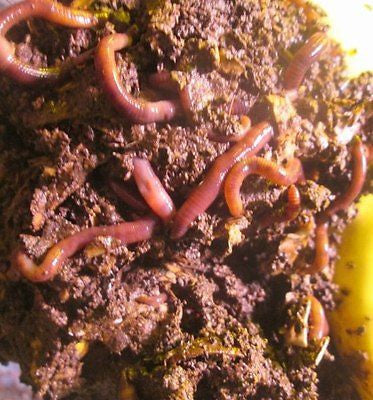Everything You Required to Know About Red Wigglers for Composting
Red wigglers, or Eisenia fetida, play a crucial function in the realm of composting, transforming organic waste into valuable dirt changes. The process of setting up a worm bin and keeping it can posture difficulties.
What Are Red Wigglers?

Native to The United States and copyright, red wigglers are surface-dwelling microorganisms that favor damp, cozy habitats abundant in breaking down natural issue. Their diet consists largely of rotting plant material, food scraps, and other natural debris, which they take in and break down successfully. As they absorb this material, they generate nutrient-rich spreadings that boost soil fertility.
Red wigglers are hermaphroditic, having both male and women reproductive body organs, and can reproduce swiftly under optimum conditions. In general, red wigglers are crucial factors to the process of reusing organic waste right into useful compost.
Benefits of Making Use Of Red Wigglers
Making use of red wigglers in composting systems supplies many advantages that improve both the effectiveness of waste management and the quality of the resulting garden compost. These worms, medically referred to as Eisenia fetida, are especially efficient at breaking down raw material, turning kitchen area scraps and lawn waste right into nutrient-rich garden compost at an accelerated rate.
One of the main benefits of utilizing red wigglers is their capability to eat huge quantities of organic product, frequently processing their weight in food waste daily. This high usage price causes quicker decomposition and minimizes the volume of waste sent out to garbage dumps. Moreover, the spreadings produced by red wigglers are rich in essential nutrients, valuable bacteria, and enzymes, making them an exceptional plant food for yards and plants.
Additionally, red wigglers flourish in a selection of environments, making them adaptable for both interior and exterior composting systems - red wigglers. Their presence in a compost bin assists to freshen the material, avoiding odors and advertising a healthy and balanced composting process. In general, employing red wigglers not only adds to efficient waste management yet additionally sustains sustainable gardening practices through the manufacturing of top notch garden compost
Establishing Your Worm Bin
To effectively establish a worm container, it is essential to pick an ideal container that satisfies the demands of red wigglers while offering a helpful environment for composting. An appropriate container can be made from plastic, timber, or metal, with a capability of at the very least 1 square foot for every single pound of worms.
Make certain the container has sufficient drain holes to avoid excess wetness, as red wigglers prosper in a moist, but not waterlogged, environment. red wigglers. The bin must additionally be aerated to provide sufficient air movement, protecting against anaerobic problems that can damage the worms
A perfect place for the worm bin is a trendy, dark area, cost-free from direct sunshine and extreme temperatures, as red wigglers choose a temperature variety of 55 to 77 levels Fahrenheit.
Prior to presenting the worms, prepare bed linens products such as shredded paper, cardboard, or coconut coir, which will provide both habitat and food. Dampen the bed linen lightly to create an inviting setting for the worms. Take into consideration positioning a cover on the bin to maintain humidity and minimize parasites, while ensuring it can be conveniently gotten rid of for upkeep.
Feeding and Treatment Guidelines
Feeding red wigglers is an essential aspect of keeping a healthy and balanced composting system. These worms flourish on a varied diet plan, mainly made up of natural materials such as fruit and vegetable scraps, coffee grounds, and crushed eggshells. It is important to avoid feeding them meat, dairy, and oily foods, as these can develop unpleasant smells and bring in parasites.
When presenting food to your worm bin, slice or shred materials into smaller pieces to help with quicker decomposition. Beginning with percentages to determine the worms' intake price, gradually raising the quantity as they adjust. It is recommended to alternate feeding locations within the container to urge extensive mixing and oygenation of the garden compost.

Troubleshooting Common Issues
Keeping a thriving worm composting system can sometimes present challenges that require attention and troubleshooting. Common problems consist of an undesirable odor, which frequently indicates overfeeding or the presence of anaerobic conditions. To remedy this, reduce the quantity of food added and guarantee appropriate oygenation by blending the bed linens product.
One more constant trouble is the escape of worms from the bin. This can happen because of excessive wetness or improper environmental conditions. Consistently check the dampness degrees, intending for a damp yet not soaked uniformity, and preserve optimum temperature levels between 60-80 ° F(15-27 ° C )to create a comfy habitat for your red wigglers.
Insects, such as fruit flies, can also attack worm containers. red wigglers. To combat this, cover food scraps with a layer of bedding or shredded paper to discourage flies from laying eggs. Furthermore, make certain that any food included is fresh and without mold, which can bring in unwanted insects
Last but not least, if your worms seem non-active, look for stress and anxiety variables such as temperature fluctuations or poor dampness. Dealing with these common problems will aid preserve a healthy and balanced and efficient worm Worm Farms Near Me composting system.
Conclusion
In summary, red wigglers, or Eisenia fetida, play a vital duty in lasting waste monitoring via vermicomposting. Their ability to successfully convert natural waste right into nutrient-dense castings boosts soil wellness and promotes plant development. Appropriate arrangement and maintenance of a worm container, together with adherence to feeding guidelines, ensure a flourishing ecological community that minimizes garbage dump payments. Addressing common concerns immediately additionally supports the effectiveness of this environmental technique, contributing to environmental sustainability and agricultural efficiency.
Comments on “Efficient red worms: Great for enriching soil”